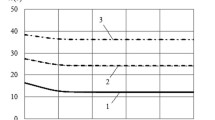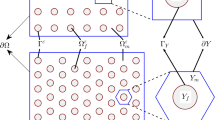A technique for determination of viscoelastic characteristics of transversal-isotropic fiber composite with isotropic components – viscoelastic matrix and elastic fiber – is proposed. The compositeunity cell consisting of two infinite coaxial cylinders is investigated by the representative element method. The solid and hollow cylinders are used to simulate the fiber and matrix, respectively. Characteristics of isotropic components of the composite are expressed through the bulk and shear moduli. The viscoelastic properties of the matrix and the homogenized composite are modeled by integral ratios of the hereditary Volterra theory. The Laplace transform is used to find the components of the axisymmetric stress-strain state of the cell and its components under uniform longitudinal tension. This make it possible to replace integral operators by algebraic functions. The effective rheological characteristics of a transversal-isotropic viscoelastic composite are determined by fitting displacements of a representative element of the viscoelastic composite and its components.

Similar content being viewed by others
References
S. Darya Zadeh and G. I. L’vov, “Numerical procedure of determining the effective mechanical characteristics of an aligned fiber composite,” Strength Mater., 47, No. 4, 536–543 (2015).
M. K. Kucher and M. M. Zarazovs’kyi, “Evaluation of micromechanical models for the prediction of effective elasticity constants of fibrous composites,” Vestn. NTUU “Kyiv Polytechnic University”, Ser. Mashinostroenie, No. 58, 24–29 (2010).
A. A. Adamov, V. P. Matveenko, N. A. Trufanov, and I. I. Shardakov, Methods of Applied Viscosity [in Russian], Ural Branch of the Russian Academy of Sciences, Ekaterinburg (2003).
A. O. Kamins’kyi, N. F. Selivanov, and Yu. O. Chornoivan, “Determination of effective characteristics of a viscoelastic composite whose relaxation of components is described by exhibitors of various fractional orders,” Math. Meth. Phys. Mech. Fields, 51, No. 3, 1–12 (2008).
Å. V. Kuimova and I. A. Trufanov, “Numerical prediction of effective thermo-viscoplastic characteristics of a unidirectional fibrous composite with viscoplastic components,” Vestn. SGU, No. 4 (70), 129–148 (2009).
M. Gosz, B. Moran, and J. D. Achenbach, “Effect of a viscoelastic interface on the transverse behavior of fiber-reinforced composites,” Int. J. Solids Struct., 27, No. 14, 1757–1771 (1991).
V. G. Martynenko and G. I. L’vov, “A numerical method for determining anisotropic visco-elastic properties of orthogonally reinforced composite material,” Vestn. NTU “KhPI”, Ser. Dynamics and Strength of Machines, No. 46 (1218), 44–51 (2016).
L. A. Fil’shtins’kyi and P. I. Zagryazhs’ka, “Modeling of composite material with viscoelastic components,” Vestn. ZNU, No. 2, 141–144 (2010).
S. Grebenyuk, M. Klymenko, O. Titova, and A. Boguslavska, “Effective longitudinal elastic modulus of the composite with viscoelastic matrix and transtropic fiber,” in: Proc. of the 20th Int. Sci. Conf. Mechanika 2015, Kaunas (2015), pp. 96–100.
S. Grebenyuk, M. Klymenko, and O. Titova, “Mechanical properties of the composite with viscoelastic isotropic matrix and transversally isotropic fiber under transverse tension,” in: Proc. of the 21st Int. Sci. Conf. Mechanika 2016, Kaunas (2016), pp. 94–97.
A. F. Bulat, V. I. Dyrda, S. N. Grebenyuk, and M. I. Klimenko, “Determination of effective characteristics of the fibrous viscoelastic composite with transversal and isotropic components,” Strength Mater., 51, No. 2, 183–192 (2019).
V. I. Dyrda, S. N. Grebenyuk, and S. I. Gomenyuk, Analytical and Numerical Methods of Calculation of Rubber Parts [in Russian], Zaporozhye National University, Dnepropetrovsk–Zaporozhye (2012).
É. I. Grigolyuk and G. M. Kulikov, Methods of Investigation of the Stress-Strain State of Multilayer Composite Shells with the Application to the Mechanics of Pneumatic Tires [in Russian], Center for Scientific and Technical Information, Blagonravov Institute of Mechanical Engineering, Russian Academy of Sciences, Moscow (1993)
Author information
Authors and Affiliations
Corresponding author
Additional information
Translated from Problemy Prochnosti, No. 5, pp. 5 – 14, September – October, 2020.
Rights and permissions
About this article
Cite this article
Bulat, À.F., Dyrda, V.I., Grebenyuk, S.M. et al. Determination of Effective Characteristics of a Fibrous Composite with Account of Viscoelastic Deformation of its Components. Strength Mater 52, 691–699 (2020). https://doi.org/10.1007/s11223-020-00221-7
Received:
Published:
Issue Date:
DOI: https://doi.org/10.1007/s11223-020-00221-7




